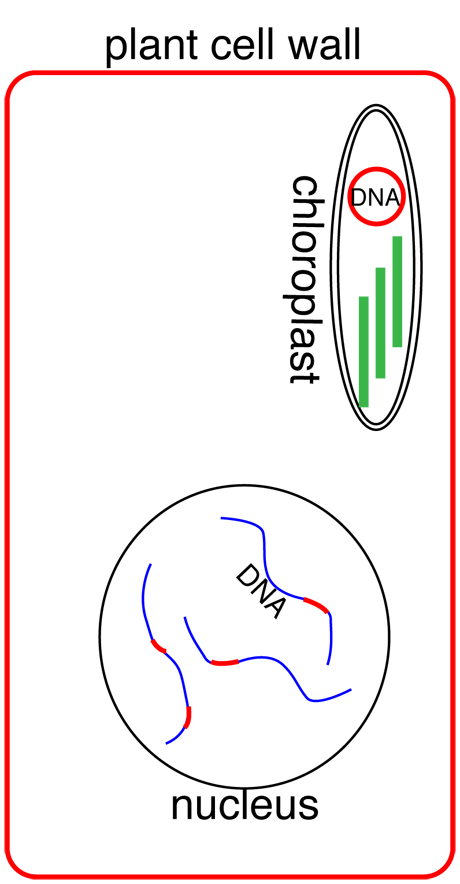Essay for July 2012: The Origin of Chloroplasts
In Chapter 5 of LOTD I introduce a few plants and algae that live on the Dock. The defining characteristic of these organisms is their ability to perform photosynthesis: using the energy of the sun to convert carbon dioxide, in the air or water, into carbohydrates. Since much of the structure of these organisms is made of carbohydrates, they are thus building themselves out of carbon dioxide. This same process also produces energy rich molecules, e.g. ATP, that are used to do the rest of the work of growing and running the organism. On page 20 of LOTD I give the structure of chlorophyll, the molecule that absorbs sunlight and thus starts the photosynthetic process.
Chlorophyll doesn't just float around inside the cell
Chlorophyll molecules are bound to membrane stacks called thylakoids, which are found inside chloroplasts, intracellular organelles about the size of bacteria. Not only is the size of the chloroplast similar to bacteria, the double wall structure of the chloroplast resembles a bacterial cell wall. Their bacterial ancestry became incontrovertible when it was found that they contained small circular DNA molecules (plant and animal cells contain long linear DNA molecules) with genes that are associated with bacteria.
Vertical and horizontal inheritance
We normally think of children inheriting the genes from their mothers and fathers: vertical inheritance (time is indicated vertically). But the structure of the chloroplast forces us to conclude that cells can (at least rarely) incorporate genes from cells that are just physical neighbors: horizontal inheritance. However, the chloroplast-cell chimera continued to evolve after the original fusion. Todays chloroplasts contain only a small fraction of the genes necessary to make their proteins. The majority of the bacterial genes have become incorporated into the nuclear genome. Thus, the chloroplast can't escape the eukaryotic cell and regain its freedom because the host cell has most of its genetic information. Of course the host cell is completely dependent on the chloroplast for biosynthesis. There will be no divorce in this kingdom.
But why did I write this essay on chloroplast?
A recent article in Scinece [1] described the most extensive analysis to date (July 2012) of the relationship between DNA sequences in the chloroplasts of algae, plants and cynobacteria. The main conclusion was that most of the chloroplast genes of extant (organisms living today) algae and plants were derived from a single endosymbiotic event that occurred about one billion years ago. The algae Cyanophora paradoxa retains most of the ancestral features inferred from all the chloroplast DNA sequences.
When did we know the origin of chloroplasts?
In 1883 Schimper observed that chloroplasts (as seen in the microscope) look like cyanobacteria, primarily because of their double membrane. In 1905 Mereschkowsky, citing this observation, suggested that chloroplasts actually were bacteria that had been engulfed by eukaryotic cells. In the 1960s Lynn Margulis, because DNA had been found to be associated with chloroplasts, again suggested that they originated from ingested bacteria. Her manuscript was rejected by 14 journals before being accepted by the Journal of Theoretical Biology in 1967. After publishing this paper, Margulis was very productive (and often controversial) and in 1999 was awarded the National Medal of Science Award by President Bill Clinton. Margulis is one of the authors of Kingdoms and Domains [2], a beautiful summary of the classification of all living organizations. This book is frequently referenced in LOTD.
References
[1] Cyanophora paradoxa Genome Elucidates Origins of Photosynthesis in Algae and Plants. Price, Dana C. et al. Science 17 Feb, v335, p843 (2012)
[2] Kingdoms and Domains. An illustrated guide to the phyla of life on earth. 4th edition. Lynn Margulis and Michael J. Chapman. Academic Press (2009)
